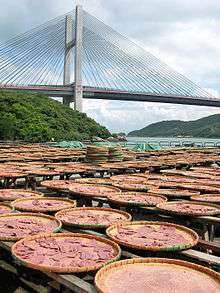Acetes
| Acetes | |
|---|---|
| Scientific classification | |
| Kingdom: | Animalia |
| Phylum: | Arthropoda |
| Subphylum: | Crustacea |
| Class: | Malacostraca |
| Order: | Decapoda |
| Infraorder: | Dendrobranchiata |
| Family: | Sergestidae |
| Genus: | Acetes H. Milne-Edwards, 1830 |
| Type species | |
| Acetes indicus H. Milne-Edwards, 1830 | |
Acetes is a genus of small, krill-like prawns. Several of its species are important for the production of shrimp paste in South East Asia, including Acetes japonicus, which is the world's most heavily fished species of wild shrimp or prawn in terms of total tonnage.[1]
Description
The genus is characterised by the loss of the fourth and fifth pairs of pereiopods.[2][3] They are small prawns, 1–4 centimetres (0.39–1.57 in) long, translucent, but with a pair of black eyes, and a number of red spots of pigment on the uropods.[3]
Life cycle
The eggs of Acetes are green. As they develop, they swell to twice their original size or more.[4] The eggs hatch early in the year, and the larvae grow, mature and spawn in the same year.[5]
Taxonomy

It includes 14 species,[6] which are listed here with their FAO endorsed common names:[7]
- Acetes americanus Ortmann, 1893 – aviu shrimp
- Acetes binghami Burkenroad, 1934
- Acetes chinensis Hansen, 1919 – northern mauxia shrimp
- Acetes erythraeus Nobili, 1905 – tsivakihini paste shrimp
- Acetes indicus H. Milne-Edwards, 1830 – Jawala paste shrimp
- Acetes intermedius Omori, 1975 – Taiwan mauxia shrimp
- Acetes japonicus Kishinouye, 1905 – akiami paste shrimp
- Acetes johni Nataraj, 1947
- Acetes marinus Omori, 1975
- Acetes natalensis Barnard, 1950
- Acetes paraguayensis Hansen, 1919
- Acetes serrulatus (Krøyer, 1859) – southern mauxia shrimp
- Acetes sibogae Hansen, 1919 – alamang shrimp
- Acetes vulgaris Hansen, 1919 – jembret shrimp
Fishery
Many species of Acetes are fished for commercially, and the different species are often not discriminated. Acetes japonicus is the most fished species of crustacean, with global production in 2008 of 558,124 tonnes (1.23×109 lb).[8] Fishers mostly use push nets and bag nets, as well as seines both on boats and from the shore.
Preparation
Only a small proportion of the entire catch is sold fresh, with most of it being dried, salted or fermented.[3] The caught prawns are washed and then mixed with 4–5 pounds (1.8–2.3 kg) of salt per 100 lb (45 kg) of prawns. The prawns are then crushed using cleavers and packed into various containers, where the paste remains for around 4 hours. After this, the paste is re-packed, before being left to mature for a month, after which it is mixed and crushed again, and then packed for sale. If a producer cannot sell the paste quickly, it can be kept for up to 6 months, mincing it every month or so.[9] The resulting paste is reported to contain 16.2% protein and 1.3% fat.[10]
See also
References
- ↑ ftp://ftp.fao.org/FI/STAT/summary/a1e.pdf
- ↑ David C. Judkins & Brian Kensley (2008). "New genera in the family Sergestidae (Crustacea: Decapoda: Penaeidea)". Proceedings of the Biological Society of Washington. 121 (1): 72–84. doi:10.2988/06-26.1.
- 1 2 3 W. Fischer & G. Bianchi, ed. (1984). "Sergestidae". Western Indian Ocean: Fishing Area 51 (PDF). FAO Species identification sheets for fishery purposes. 5. Rome: Food and Agriculture Organization.
- ↑ Makoto Omori (1975). "The biology of pelagic shrimps in the ocean". In Frederick Stratten Russell & Maurice Yonge. Advances in Marine Biology. Volume 12. Academic Press. pp. 233–324. ISBN 978-0-12-026112-3.
- ↑ Chiaki Koizumi (2001). "Ecology of prawns and shrimps". Prawns of Japan and the World. CRC Press. pp. 29–73. ISBN 978-90-5410-769-9.
- ↑ WoRMS (2010). "Acetes H. Milne-Edwards, 1830". World Register of Marine Species. Retrieved April 24, 2010.
- ↑ Lipke B. Holthuis (1980). "Superfamily Sergestoidea". Vol. 1 - Shrimps and prawns of the world. An Annotated Catalogue of Species of Interest to Fisheries (PDF). FAO Species Catalogue. Rome: Food and Agriculture Organization. ISBN 92-5-100896-5.
- ↑ "Acetes japonicus (Kishinouye, 1905)". Species Fact Sheets. Food and Agriculture Organization. Retrieved April 25, 2010.
- ↑ Keith H. Steinkraus (1996). "Indigenous Amino Acid / Peptide Sauces and Pastes with Meatlike Flavors". Handbook of indigenous fermented foods. Volume 73 of Food science and technology (2nd ed.). CRC Press. pp. 509–654. ISBN 978-0-8247-9352-4.
- ↑ Torry Research Station (1989). "Akiami paste shrimp". Yield and nutritional value of the commercially more important fish species. Volume 309 of FAO fisheries technical paper. Food and Agriculture Organization. p. 23. ISBN 978-92-5-102870-4.